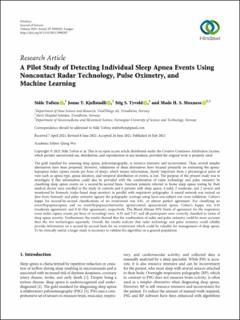| dc.contributor.author | Toften, Ståle | |
| dc.contributor.author | Kjellstadli, Jonas Tøgersen | |
| dc.contributor.author | Tyvold, Stig Sverre | |
| dc.contributor.author | Moxness, Mads Henrik Strand | |
| dc.date.accessioned | 2022-09-27T09:32:24Z | |
| dc.date.available | 2022-09-27T09:32:24Z | |
| dc.date.created | 2021-10-05T18:04:06Z | |
| dc.date.issued | 2021 | |
| dc.identifier.citation | Journal of Sensors. 2021, 2021 1-9. | en_US |
| dc.identifier.issn | 1687-725X | |
| dc.identifier.uri | https://hdl.handle.net/11250/3021688 | |
| dc.description.abstract | The gold standard for assessing sleep apnea, polysomnography, is resource intensive and inconvenient. Thus, several simpler alternatives have been proposed. However, validations of these alternatives have focused primarily on estimating the apnea-hypopnea index (apnea events per hour of sleep), which means information, clearly important from a physiological point of view such as apnea type, apnea duration, and temporal distribution of events, is lost. The purpose of the present study was to investigate if this information could also be provided with the combination of radar technology and pulse oximetry by classifying sleep apnea events on a second-by-second basis. Fourteen patients referred to home sleep apnea testing by their medical doctor were enrolled in the study (6 controls and 8 patients with sleep apnea; 4 mild, 2 moderate, and 2 severe) and monitored by Somnofy (radar-based sleep monitor) in parallel with respiratory polygraphy. A neural network was trained on data from Somnofy and pulse oximetry against the polygraphy scorings using leave-one-subject-out cross-validation. Cohen’s kappa for second-by-second classifications of no event/event was 0.81, or almost perfect agreement. For classifying no event/hypopnea/apnea and no event/hypopnea/obstructive apnea/central apnea/mixed apnea, Cohen’s kappa was 0.43 (moderate agreement) and 0.36 (fair agreement), respectively. The Bland-Altman 95% limits of agreement for the respiratory event index (apnea events per hour of recording) were -8.25 and 7.47, and all participants were correctly classified in terms of sleep apnea severity. Furthermore, the results showed that the combination of radar and pulse oximetry could be more accurate than the two technologies separately. Overall, the results indicate that radar technology and pulse oximetry could reliably provide information on a second-by-second basis for no event/event which could be valuable for management of sleep apnea. To be clinically useful, a larger study is necessary to validate the algorithm on a general population. | en_US |
| dc.language.iso | eng | en_US |
| dc.publisher | Hindawi | en_US |
| dc.rights | Navngivelse 4.0 Internasjonal | * |
| dc.rights.uri | http://creativecommons.org/licenses/by/4.0/deed.no | * |
| dc.title | A pilot study of scoring individual sleep apnea events using non-contact radar technology, pulse oximetry and machine learning (Somnofy®) | en_US |
| dc.title.alternative | A pilot study of scoring individual sleep apnea events using non-contact radar technology, pulse oximetry and machine learning (Somnofy®) | en_US |
| dc.type | Peer reviewed | en_US |
| dc.type | Journal article | en_US |
| dc.description.version | publishedVersion | en_US |
| dc.source.pagenumber | 1-9 | en_US |
| dc.source.volume | 2021 | en_US |
| dc.source.journal | Journal of Sensors | en_US |
| dc.identifier.doi | 10.1155/2021/2998202 | |
| dc.identifier.cristin | 1943558 | |
| dc.relation.project | Norges forskningsråd: 231741 | en_US |
| cristin.ispublished | true | |
| cristin.fulltext | original | |
| cristin.qualitycode | 1 | |

